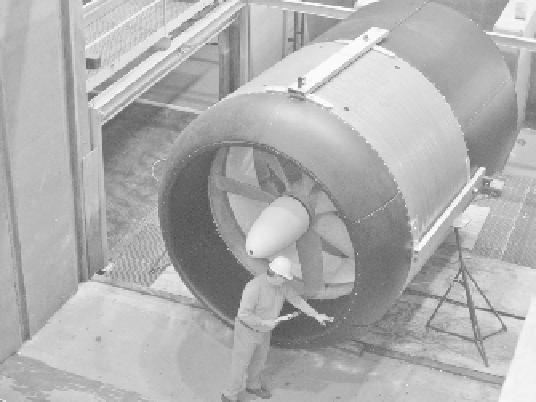Environmental Engineering Reference
In-Depth Information
FIGURE 7.9
Free-flow water current turbine used in rivers and canals. (From NREL,
Image Gallery
, National Renewable Energy Laboratory, Washington, DC, 2014,
http://
a
lTeraTion
oF
r
iver
or
o
Cean
C
urrenTs
or
W
aves
The extraction of kinetic energy from river and ocean currents or tides will reduce
water velocities in the vicinity (i.e., near field) of the project (Bryden et al., 2004).
Large numbers of devices in a river will reduce water velocities, increase water sur-
face elevations, and decrease flood conveyance capacity. These effects would be pro-
portional to the number and size of structures installed in the water. Rotors, foils,
mooring and electrical cables, and field structures will all act as impediments to
water movement. The resulting reduction in water velocities could, in turn, affect
the transport and deposition of sediment, organisms living on or in the bottom sedi-
ments, and plants and animals in the water column. Conversely, moving rotors and
foils might increase mixing in systems where salinity or temperature gradients are
well defined. Changes in water velocity and turbulence will vary greatly, depending
on distance from the structure. For small numbers of units, the changes are expected
to dissipate quickly with distance and are expected to be only localized; however,
for large arrays, the cumulative effects may extend to a greater area. The alterations
of circulation/mixing patterns caused by large numbers of structures might cause
changes in nutrient inputs and water quality, which could in turn lead to eutrophica-
tion, hypoxia, and effects on the aquatic food web.
The presence of floating wave energy converters will alter wave heights and struc-
tures, both in the near field (within meters of the units or project) and, if installed
in large numbers, potentially in the far field (extending meters to kilometers out
from the project). The above-water structures of wave energy converters will act as
a localized barrier to wind and thus reduce wind-wave interactions. Many of the
changes would not directly relate to environmental impacts; for example, impacts

